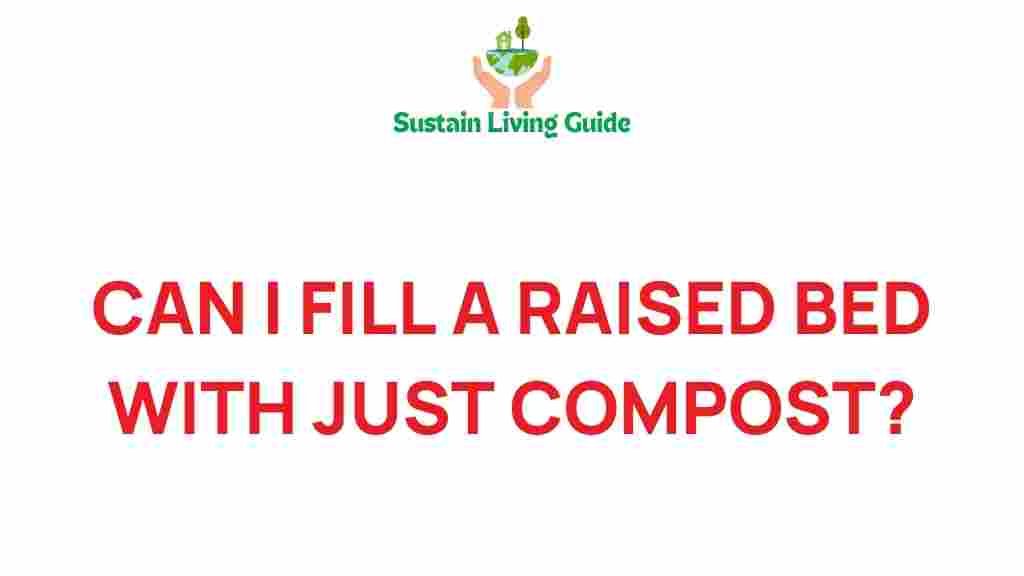Unlocking the Secrets: Can You Fill a Raised Bed with Just Compost?
Creating a thriving garden often begins with deciding how to fill your raised bed. One popular question among gardeners is whether you can fill a raised bed with just compost. In this article, we’ll explore the ins and outs of using compost as the sole medium for your raised bed, discussing its benefits, challenges, and best practices to help you achieve a successful garden.
Understanding Raised Beds
Raised beds are garden plots that are elevated above the surrounding soil, usually enclosed by wooden boards, bricks, or other materials. They offer numerous advantages:
- Improved drainage: Raised beds help excess water drain away, reducing the risk of root rot.
- Better soil quality: You have complete control over the soil composition, allowing for optimal growing conditions.
- Extended growing season: The soil warms up faster in spring, leading to earlier planting.
- Reduced weeds: Less soil contact can mean fewer weed seeds taking root.
What is Compost?
Compost is decomposed organic matter, created through the natural breakdown of plant and food waste. It is rich in nutrients and beneficial microorganisms, making it an excellent amendment for garden soil. The nutrient content varies based on the materials used, but compost generally improves soil structure, encourages healthy root growth, and enhances moisture retention.
Can You Fill a Raised Bed with Just Compost?
The short answer is: yes, you can fill a raised bed with just compost. However, there are several factors to consider before going this route.
Benefits of Using Only Compost in Your Raised Bed
Using only compost in your raised bed has several advantages:
- Nutrient-Rich: Compost is packed with nutrients essential for plant growth.
- Microbial Activity: A healthy compost mix promotes beneficial microbial activity that can help plants thrive.
- Environmentally Friendly: Utilizing compost is a sustainable practice, reducing waste while enhancing your garden.
Challenges of Filling a Raised Bed with Only Compost
While there are benefits to using solely compost, it’s essential to be aware of potential challenges:
- Soil Structure: Pure compost may lack structure, leading to poor drainage.
- Compaction: Compost can settle over time, resulting in a compacted environment that restricts root growth.
- Nutrient Imbalance: Some plants may require more specific nutrient profiles than what compost alone can provide.
Step-by-Step Process to Fill a Raised Bed with Compost
If you’ve decided to fill your raised bed with compost, follow these steps for the best results:
Step 1: Choose Your Compost
Not all compost is created equal. Look for quality, well-aged compost that is dark and crumbly. You can either purchase it from garden centers or make your own if you have the resources. Ensure it is free from contaminants and has decomposed fully.
Step 2: Build Your Raised Bed
Construct your raised bed using rot-resistant materials like cedar or composite boards. Ensure the dimensions fit your garden space, typically ranging from 4×4 feet to 4×8 feet.
Step 3: Fill with Compost
Carefully fill your raised bed with compost, leaving about 1-2 inches of space from the top to allow for mulch and prevent overflow during watering.
Step 4: Level the Surface
Once filled, use a rake to level the surface of the compost. This helps promote even water distribution and ensures a uniform planting surface.
Step 5: Let It Settle
Before planting, allow the compost to settle for a week or two. This will help minimize compaction and create a stable environment for your plants.
Step 6: Planting
Once settled, you can start planting. Choose plants that thrive in nutrient-rich environments. Some good options include:
- Leafy greens (lettuce, spinach)
- Root vegetables (carrots, radishes)
- Herbs (basil, parsley)
Troubleshooting Tips for Raised Beds Filled with Compost
Even when using compost, you might encounter some challenges. Here are some troubleshooting tips:
- Compaction: If you notice compaction, add more compost or organic materials to aerate the bed.
- Excess Drainage: If water drains too quickly, mix in some garden soil or peat moss to retain moisture.
- Plant Growth Issues: If your plants are not thriving, consider supplementing with balanced fertilizers to address nutrient imbalances.
Conclusion
Filling a raised bed with just compost can be a viable option, especially for nutrient-hungry plants. However, it’s crucial to be aware of the potential challenges and take the necessary steps to ensure a successful growing environment. By using quality compost and following the outlined steps, you can create a thriving garden that produces healthy, bountiful crops.
For more gardening tips and techniques, visit our gardening resources page. If you want to learn more about composting, check out this detailed guide on how to create your own compost at home.
This article is in the category Eco-friendly and created by SustainLivingGuide Team
